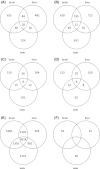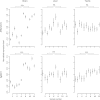Early gene expression divergence between allopatric populations of the house mouse (Mus musculus domesticus)
- PMID: 23532401
- PMCID: PMC3605846
- DOI: 10.1002/ece3.447
Early gene expression divergence between allopatric populations of the house mouse (Mus musculus domesticus)
Abstract
Divergence of gene expression is known to contribute to the differentiation and separation of populations and species, although the dynamics of this process in early stages of population divergence remains unclear. We analyzed gene expression differences in three organs (brain, liver, and testis) between two natural populations of Mus musculus domesticus that have been separated for at most 3000 years. We used two different microarray platforms to corroborate the results at a large scale and identified hundreds of genes with significant expression differences between the populations. We find that although the three tissues have similar number of differentially expressed genes, brain and liver have more tissue-specific genes than testis. Most genes show changes in a single tissue only, even when expressed in all tissues, supporting the notion that tissue-specific enhancers act as separable targets of evolution. In terms of functional categories, in brain and to a smaller extent in liver, we find transcription factors and their targets to be particularly variable between populations, similar to previous findings in primates. Testis, however, has a different set of differently expressed genes, both with respect to functional categories and overall correlation with the other tissues, the latter indicating that gene expression divergence of potential importance might be present in other datasets where no differences in fraction of differentially expressed genes were reported. Our results show that a significant amount of gene expression divergence quickly accumulates between allopatric populations.
Keywords: Evolution; gene expression; population divergence; wild mice.
Figures






Similar articles
-
Copy number variants and selective sweeps in natural populations of the house mouse (Mus musculus domesticus).Front Genet. 2014 Jun 3;5:153. doi: 10.3389/fgene.2014.00153. eCollection 2014. Front Genet. 2014. PMID: 24917877 Free PMC article. Review.
-
Contrasting evolution of expression differences in the testis between species and subspecies of the house mouse.Genome Res. 2007 Jan;17(1):42-9. doi: 10.1101/gr.5683806. Epub 2006 Oct 12. Genome Res. 2007. PMID: 17038563 Free PMC article.
-
Paternal imprinting of mating preferences between natural populations of house mice (Mus musculus domesticus).Mol Ecol. 2013 May;22(9):2549-62. doi: 10.1111/mec.12271. Epub 2013 Mar 18. Mol Ecol. 2013. PMID: 23506395
-
A test of the neutral model of expression change in natural populations of house mouse subspecies.Evolution. 2010 Feb 1;64(2):549-60. doi: 10.1111/j.1558-5646.2009.00818.x. Epub 2009 Aug 6. Evolution. 2010. PMID: 19674092
-
Mitochondrial DNA evolution in mice.Genetics. 1983 Nov;105(3):681-721. doi: 10.1093/genetics/105.3.681. Genetics. 1983. PMID: 6315529 Free PMC article. Review.
Cited by
-
Copy number variants and selective sweeps in natural populations of the house mouse (Mus musculus domesticus).Front Genet. 2014 Jun 3;5:153. doi: 10.3389/fgene.2014.00153. eCollection 2014. Front Genet. 2014. PMID: 24917877 Free PMC article. Review.
-
Extensive Adaptive Variation in Gene Expression within and between Closely Related Horseshoe Bats (Chiroptera, Rhinolophus) Revealed by Three Organs.Animals (Basel). 2022 Dec 6;12(23):3432. doi: 10.3390/ani12233432. Animals (Basel). 2022. PMID: 36496954 Free PMC article.
-
Divergence in gene expression within and between two closely related flycatcher species.Mol Ecol. 2016 May;25(9):2015-28. doi: 10.1111/mec.13596. Epub 2016 Apr 2. Mol Ecol. 2016. PMID: 26928872 Free PMC article.
-
Social exclusion changes histone modifications H3K4me3 and H3K27ac in liver tissue of wild house mice.PLoS One. 2015 Aug 12;10(8):e0133988. doi: 10.1371/journal.pone.0133988. eCollection 2015. PLoS One. 2015. PMID: 26267652 Free PMC article.
-
Evolution of a New Testis-Specific Functional Promoter Within the Highly Conserved Map2k7 Gene of the Mouse.Front Genet. 2022 Jan 5;12:812139. doi: 10.3389/fgene.2021.812139. eCollection 2021. Front Genet. 2022. PMID: 35069705 Free PMC article.
References
-
- Boursot P, Auffray J, Britton-Davidian J, Bonhomme F. The evolution of house mice. Ann. Rev. Ecol. Evol. Syst. 1993;24:119–152.
-
- Brawand D, Soumillon M, Necsulea A, Julien P, Csárdi G, Harrigan P, et al. The evolution of gene expression levels in mammalian organs. Nature. 2011;478:343–348. - PubMed
-
- Carroll SB. Evo-devo and an expanding evolutionary synthesis: a genetic theory of morphological evolution. Cell. 2008;134:25–36. - PubMed
LinkOut - more resources
Full Text Sources
Other Literature Sources
Molecular Biology Databases

